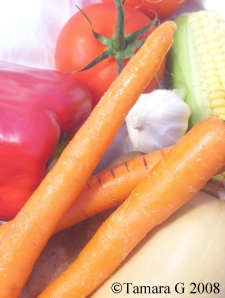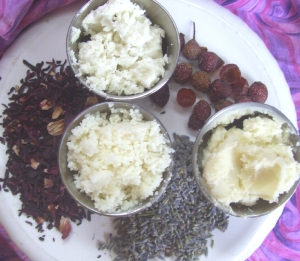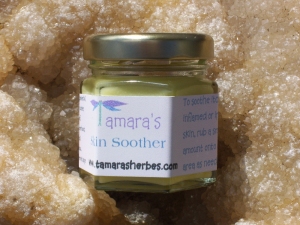An interesting comment posted to my blog in response to my post “Feeling the Blues?” and it got me to thinkin’. Sometimes that’s a dangerous thing, but I think this thought might be a good one!
I often forget when I’m writing these posts that you all haven’t done the same research as I have. I forget that it has taken me over a decade of frequent and intense studying to come to the conclusions that I have about herbs and their benefits. In my attempt to share my information with you all in a limited amount of time and space, I’m afraid I’m guilty of skimming over many things because I accept them as fact and I fail to keep in mind that they are really only opinions.
So, in an attempt to remedy this oversight, I’m writing this post.
Once more, for the record, here is the warning that is posted in various forms on my website, my Etsy profile and in several of my blog posts:
Warning: Please consult a physician before consuming any type of herb or flower, as many of them will interfere with medications. While we at Tamara’s are careful to use only those herbs considered safe, it is always possible that someone will have a negative reaction. Please be advised that I am not a medical doctor and am not licensed to give medical advice. None of the products suggested have been approved by the FDA and none of the information contained in any of these posts is meant to diagnose or treat any type of illness. Always consult your healthcare advisor before taking any herbs in any form for any reason.
Okay, now that we have that out of the way…
Here is the comment (in its entirety) that got me to thinking about all of this:
“St. John’s wort has only been proven slightly more effective at treating mild to moderate depression than placebo. It had no effect on severe depression.
The following is taken from the National Center for Complementary and Alternative Medicine’s website. http://nccam.nih.gov/
*St. John’s wort may cause increased sensitivity to sunlight. Other side effects can include anxiety, dry mouth, dizziness, gastrointestinal symptoms, fatigue, headache, or sexual dysfunction.
*Research shows that St. John’s wort interacts with some drugs. The herb affects the way the body processes or breaks down many drugs; in some cases, it may speed or slow a drug’s breakdown. Drugs that can be affected include:
*Antidepressants
*Birth control pills
*Cyclosporine, which prevents the body from rejecting transplanted organs
*Digoxin, which strengthens heart muscle contractions
*Indinavir and possibly other drugs used to control HIV infection
*Irinotecan and possibly other drugs used to treat cancer
*Warfarin and related anticoagulants
*When combined with certain antidepressants, St. John’s wort may increase side effects such as nausea, anxiety, headache, and confusion.
There you go. Only one of the herbs you use to treat depression and it’s just as dangerous as the two medications you showed.
While I’m all for alternative medicine, it’s important for people to know all the facts. The herbs you use may be effective for treating mild to moderate depression in patients taking no other medications, but there still possible dangerous side effects. The key is Talk to your Doctor! Before starting any treatment, natural or not, Talk to your Doctor.”
Now, I have to be honest. When I first read this comment, my initial reaction was aggravation. I can’t help it. Who likes to be called onto the carpet, after all? Then, it occurred to me that being called onto the carpet would give me a chance to further my point and perhaps clarify this issue a bit more.
Jozie, the poster of the comment makes several good points. The website she mentions is one I often use myself. It has a wealth of information for anyone interested in learning more about alternative health options.
She also points out, as I did in my original post, that St. John’s wort is well known for its ability to interfere with a variety of medications. It decreases the effectiveness of some drugs and increases the effectiveness of others. This is true of many other herbs, also.
However, as to the effectiveness of St. John’s wort I can only say, the results vary from study to study. There are many reasons for this. With any herb, it is especially difficult to test the effectiveness because each plant will produce a different level of medicinal characteristics. The strength of the herb used will vary according to growing conditions, harvesting conditions, drying conditions, age of the plant, length of time it has been stored, how it was stored…the list is long. The truth is, it is darn near impossible to get the exact same level of effectiveness consistently. So, it’s easy to see why the results of any herbal testing is difficult.
Another thing to consider when testing the effectiveness of herbs is, who is doing the study. As a general rule, I’ve found that testing by those agencies associated with the government and medical establishment (doctors, hospitals, pharmecuetical companies, etc.) show that most herbs are ineffective. If the agency doing the testing is funded by those in the natural/alternative establishments, most herbs are shown to be highly effective.
The truth lies right there in the middle. Herbs and other forms of alternative medicine are exactly like prescription medicines in their effectiveness. What works a miracle for me may not help you a whit. The beauty of herbs is, unless you have an allergic reaction, trying new herbs and herbal formulas will yield few, if any, negative short-term effects and even less long-term effects. In most cases, if the herb doesn’t heal you, it won’t hurt you either.
Just for giggles, here is a link to the results of one study concerning the effectiveness of St. John’s wort against a placebo and a standard treatment drug. Their results?
“Hypericum extracts were significantly superior to placebo (ratio = 2.67; 95% confidence interval 1.78 to 4.01) and similarly effective as standard antidepressants (single preparations 1.10; 0.93 to 1.31, combinations 1.52; 0.78 to 2.94). There were two (0.8%) drop outs for side effects with hypericum and seven (3.0%) with standard antidepressant drugs. Side effects occurred in 50 (19.8%) patients on hypericum and 84 (52.8%) patients on standard antidepressants.”
‘Similarly effective as standard antidepressants’ means it works as well as the common prescriptions for depression. To further toot the horn of St. John’s wort, only 19.8% of the people studied had adverse side effects vs 52.8% who took the standard antidepressant. I like those odds much better!
But, we aren’t done, yet. Let’s take a peek at those side effects. “…anxiety, dry mouth, dizziness, gastrointestinal symptoms, fatigue, headache, or sexual dysfunction.” Sounds unpleasant. This is where an experienced herbalist is needed and a perfect example of why you should never take herbs without consulting an experienced practitioner. A good herbalist knows that St. John’s wort presents these risks. They will also know that St. John’s wort can be combined with other herbs to counterbalance these adverse effects. For instance, peppermint will help calm naseau and any gastrointestinal symptoms, as well as headaches, fatigue and sexual dysfunction, as it is a system stimulant. Ginger, too, will help with gastrointestinal problems.
A good herbalist will also understand that, in a blend of herbs, the dosage of St. John’s wort can be reduced because the other herbs will work in conjuction with it, thereby increasing the anti-depressant/anxiety characteristics while decreasing the risk of negative side effects. This is not an option with chemically produced prescription medicines.
While it is true that herbs are serious medicine and can produce side effects, the risk is much lower and much easier to manage and counterbalance. I am still searching for any bit of proof that herbs, when used properly, have caused long-term side effects. To date, all I’ve come across are short-term side effects that disappear within days of stopping usage. This is not the case with prescription medicines.
Another point to consider is that, as with all herbs, you have positive side effects, also. St. John’s wort doesn’t just lend itself to relieving depression and anxiety. Check out this list of other uses for St. John’s wort:
Psychovegitative disorders, sciatica, viral infections (including Herpes simplex 1 and 2), hepatitis C, influenza, murine cytomegalovirus, poliovirus, bronchitis, asthma, gallbladder disease, nocturnal enuresis, gout, rheumatism, contusions, inflammation, myalgia, burns, hemorrhoids, vitiligo, tonsilitis and dermatoses.
Pretty impressive, huh?
It should also be pointed out that St. John’s wort is the exception in herbal medicine rather than the rule. It has more adverse effects than most other herbs and a greater effect on prescription medicines than most other herbs. Perhaps that is simply because it has been studied more than most other herbs…who knows for sure.
When it comes right down to it, though, Jozie is right. Always consult your healthcare professional before taking any herbs. Alway consult an herbalist before taking any herbs, also, as they will likely know more about them than your doctor. Then, go and do a little research on your own. It is your health…your body. Know what is going into it. Don’t take your doctors word or your herbalists word. Don’t even take my word for it. There are numerous books, website articles, journals and periodicals that contain a wealth of information on herbs and their benefits and risks. Read up and decide what is best for you!
















